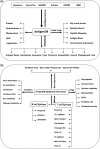AntigenDB: an immunoinformatics database of pathogen antigens
- PMID: 19820110
- PMCID: PMC2808902
- DOI: 10.1093/nar/gkp830
AntigenDB: an immunoinformatics database of pathogen antigens
Abstract
The continuing threat of infectious disease and future pandemics, coupled to the continuous increase of drug-resistant pathogens, makes the discovery of new and better vaccines imperative. For effective vaccine development, antigen discovery and validation is a prerequisite. The compilation of information concerning pathogens, virulence factors and antigenic epitopes has resulted in many useful databases. However, most such immunological databases focus almost exclusively on antigens where epitopes are known and ignore those for which epitope information was unavailable. We have compiled more than 500 antigens into the AntigenDB database, making use of the literature and other immunological resources. These antigens come from 44 important pathogenic species. In AntigenDB, a database entry contains information regarding the sequence, structure, origin, etc. of an antigen with additional information such as B and T-cell epitopes, MHC binding, function, gene-expression and post translational modifications, where available. AntigenDB also provides links to major internal and external databases. We shall update AntigenDB on a rolling basis, regularly adding antigens from other organisms and extra data analysis tools. AntigenDB is available freely at http://www.imtech.res.in/raghava/antigendb and its mirror site http://www.bic.uams.edu/raghava/antigendb.
Figures
References
Publication types
MeSH terms
Substances
LinkOut - more resources
Full Text Sources
Other Literature Sources
Medical
Research Materials




